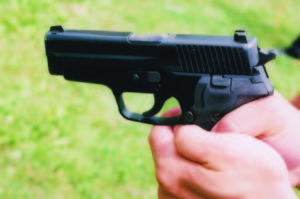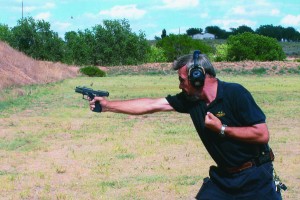Free: Guide to Buying Used Glocks
 If you're in the market for a new-to-you handgun, be sure to enter your e-mail in the box below. You'll get a free guide to buying used Glocks. You'll also receive free e-newsletters from Gun Digest and partners.
If you're in the market for a new-to-you handgun, be sure to enter your e-mail in the box below. You'll get a free guide to buying used Glocks. You'll also receive free e-newsletters from Gun Digest and partners.
[form id=”191906″]

In the 1970s, the SIG-Sauer brand was new to American firearms enthusiasts, and the company's pistols took America by storm. For a long time, the P226 was the most popular of the series, for very good reasons, according to Massad Ayoob. He shares his views in detail, in Massad Ayoob's Greatest Handguns of the World Volume 2:
Shooting the P226 by Massad Ayoob
The P-series double action SIGs are all “point and shoot” guns, whose designs do not require manual safeties. Some single action variations, the P220 SAO and the X-5 for example, have ergonomic frame-mounted thumb safeties that allow them to be carried cocked and locked. If you prefer a safety catch with your double action mechanism, you’ll need to look to Beretta, S&W, Ruger, or any of several other makers. On the other hand, if you buy into the KISS principle (Keep It Simple, Stupid) theory that a safety/decocker on a double action pistol should only be used as a decocker, it should only function as a decocker. Otherwise, there is always the chance of the gun being inadvertently left on safe. An owner who draws and pulls the trigger is in for a nasty, silent surprise, because if he has not been using the lever as a safety he will not be habituated to flip it into the fire position.
The KISS principle’s permeation of police training helped boost SIG sales considerably. Beretta, Ruger, and S&W have decocker only models, with their spring-loaded levers mounted on the slides. Many people’s thumbs can’t reach that location as effectively as they can the SIG’s decocking lever, which is located on the left side of the frame behind the trigger. In the right hand, it is actuated by the thumb, and in the left, by the trigger finger. This kind of effective ergonomics is one reason for the SIG’s popularity among people who carry guns constantly and shoot them a lot.

One ergonomic downside, however, is the location of the slide lock lever. As the photos show, it is farther back on the frame than is the case with most other pistols. A right-handed shooter habituated to the high thumb grasp will over-ride the lever and prevent the slide from locking back when the pistol is empty. This problem can be solved with a lower thumb grasp. With no safety for the thumb to be verifying in the “fire” position, there is no need for that digit to ride that high on a SIG-Sauer.
Mechanically, the pistols are superb. Expect your P226 in 9mm to shoot under two inches with most ammunition, sometimes well under. It may be a little looser than that with the .40 S&W round, which has never earned a great reputation for accuracy. On the other hand, in .357 SIG it is an absolute tack-driver. That cartridge is inherently more accurate than the .40. When testing various specimens for The Gun Digest Book of SIG-Sauer, a P226 fired from the bench at 25 yards put five CCI Gold Dot 125 grain .357 JHPs into an inch.
People will tell you that it’s difficult to transition between the double action first shot and the single action follow-ups with a traditional double action pistol like the standard P226. Actually, it’s all a matter of technique. Use a firm grip, get the index finger to the distal joint on the trigger for more leverage, and keep it there for the whole string of fire. If the first double action shot is giving you trouble, spend a day at the range doing all DA shooting. Fire, decock, fire, decock…a long session or two of this will condition your finger to both trigger pulls.
The short-reach optional trigger helps fit this pistol to a great many hands, including my own. It’s a simple retrofit for a gunsmith or SIGARMS certified armorer to accomplish, or you can just send it back to SIGARMS at Exeter for the retrofit. Magazines? Trust only SIG and MecGar brands. Grips? Springs between the frame and the grip panel are sensitive to incorrectly sized stocks. Hogue grips seem to work out well. SIG grip screws tend to work loose, and you want to pay constant attention to that.
 For more hist
For more hist ory and discussion of the P226, stop by the Gun Digest Store for your copy of Massad Ayoob's Greatest Handguns of the World Volume 2. And if you missed Volume 1, be sure to put one of those in your cart while you're there. Both of these volumes provide Ayoob's reviews after shooting these great handguns, as well as the history of each gun in the colorful words of this esteemed handgunner.
ory and discussion of the P226, stop by the Gun Digest Store for your copy of Massad Ayoob's Greatest Handguns of the World Volume 2. And if you missed Volume 1, be sure to put one of those in your cart while you're there. Both of these volumes provide Ayoob's reviews after shooting these great handguns, as well as the history of each gun in the colorful words of this esteemed handgunner.
Thanks for visiting gundigest.com, and for reading the Inside Gun Digest Books blog.

